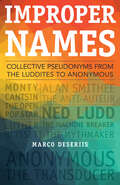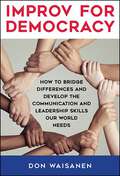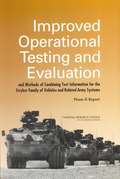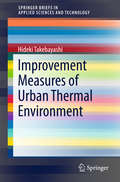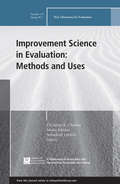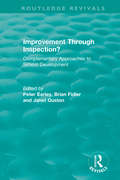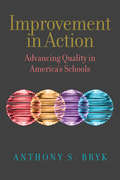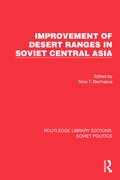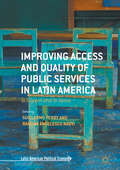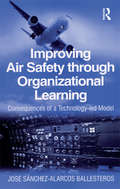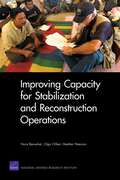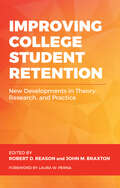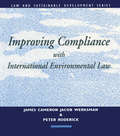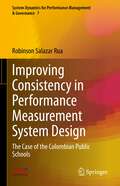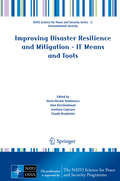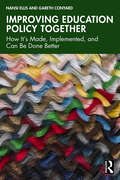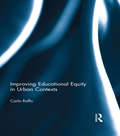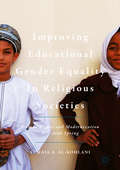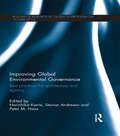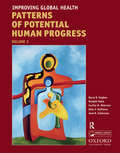- Table View
- List View
Improper Life: Technology and Biopolitics from Heidegger to Agamben (Posthumanities)
by Timothy C. CampbellHas biopolitics actually become thanatopolitics, a field of study obsessed with death? Is there something about the nature of biopolitical thought today that makes it impossible to deploy affirmatively? If this is true, what can life-minded thinkers put forward as the merits of biopolitical reflection? These questions drive Improper Life, Timothy C. Campbell&’s dexterous inquiry-as-intervention.Campbell argues that a &“crypto-thanatopolitics&” can be teased out of Heidegger&’s critique of technology and that some of the leading scholars of biopolitics—including Michel Foucault, Giorgio Agamben, and Peter Sloterdijk—have been substantively influenced by Heidegger&’s thought, particularly his reading of proper and improper writing. In fact, Campbell shows how all of these philosophers have pointed toward a tragic, thanatopolitical destination as somehow an inevitable result of technology. But in Improper Life he articulates a corrective biopolitics that can begin with rereadings of Foucault (especially his late work regarding the care and technologies of the self), Freud (notably his writings on the drives and negation), and Gilles Deleuze (particularly in the relation of attention to aesthetics).Throughout Improper Life, Campbell insists that biopolitics can become more positive and productively asserts an affirmative technē not thought through thanatos but rather practiced through bíos.
Improper Names: Collective Pseudonyms from the Luddites to Anonymous (A Quadrant Book)
by Marco DeseriisImproper Names offers a genealogy and theory of the &“improper name,&” which author Marco Deseriis defines as the adoption of the same pseudonym by organized collectives, affinity groups, and individual authors. Although such names are often invented to pursue a specific social or political agenda, they are soon appropriated for different and sometimes diverging purposes. This book examines the tension arising from struggles for control of a pseudonym&’s symbolic power.Deseriis provides five fascinating and widely varying case studies. Ned Ludd was the legendary and eponymous leader of the English Luddites, textile workers who threatened the destruction of industrial machinery and then advanced a variety of economic and political demands. Alan Smithee—an alias coined by Hollywood film directors in 1969 in order to disown films that were recut by producers—became a contested signature and was therefore no longer effective to signal prevarication to Hollywood insiders. Monty Cantsin was an &“open pop star&” created by U.S. and Canadian artists in the late 1970s to critique bourgeois notions of authorship, but its communal character was compromised by excessive identification with individual users of the name. The Italian media activists calling themselves Luther Blissett, aware of the Cantsin experience, implemented measures to prevent individuals from assuming the alias, which was used to author media pranks, sell apocryphal manuscripts to publishers, fabricate artists and artworks, and author best-selling novels. The longest chapter here is devoted to the contemporary &“hacktivist&” group known as Anonymous, which protests censorship and restricted access to information and information technologies.After delving into a rich philosophical debate on community among those who have nothing in common, the book concludes with a reflection on how the politics of improper names affects present-day anticapitalist social movements such as Occupy and 15-M.
Improv for Democracy: How to Bridge Differences and Develop the Communication and Leadership Skills Our World Needs (SUNY series in New Political Science)
by Don WaisanenWhile much has been written about what democracies should look like, much less has been said about how to actually train citizens in democratic perspectives and skills. Amid the social and political crises of our time, many programs seeking to bridge differences between citizens draw from the surprising field of improvisational theater. Improv trains people to engage with one another in ways that promote empathy and understanding. Don Waisanen demonstrates how improv-based teaching and training methods can forward the communication, leadership, and civic skills our world urgently needs. Waisanen includes specific exercises and thought experiments that can be used by educators; advocates for civic engagement and civil discourse; practitioners and scholars in communication, leadership, and conflict management; training and development specialists; administrators looking to build new curricula or programming; and professionals seeking to embed productive, sustainable, and socially responsible forms of interaction in and across organizations. Ultimately this book offers a new approach for helping people become more creative, heighten awareness, think faster, build confidence, operate flexibly, improve expression and governance skills, and above all, think and act more democratically.
Improved Operational Testing and Evaluation and Methods of Combining Test Information for the Stryker Family of Vehicles and Related Army Systems: Phase II Report
by National Research CouncilThis report assesses the US Army's planned initial operational test and evaluation of Stryker vehicles, the intended platform for the Stryker Brigade Combat Team (SBCT), and argues for the use of information-combining techniques in the operational evaluation of Stryker and similar systems. Recommendations are given on test measures, statistical design, data analysis, and assessment of the Stryker/SBCT operational test in a broad context. Annotation ©2004 Book News, Inc. , Portland, OR (booknews. com)
Improvement Measures of Urban Thermal Environment
by Hideki TakebayashiMaximizing readers' insights into urban and architectural environmental planning with consideration for the thermal environment, this work highlights how various urban heat-island strategies have been developed and their effectiveness in urban areas. Specific measures to combat the urban heat-island phenomenon, including improvement of surface cover, reduction of exhaust heat, improvement of ventilation are summarized and various heat-island measurement technologies, which have been proposed in recent years, are organized systematically based on surface- heat budget and surface boundary layer models. With suggestions for the selection of appropriate heat-island technologies depending on the location, this book elucidates the relationship between the thermal environment and urban block form characteristics. Covering the latest research findings, this book is of interest for all those concerned with environmentally friendly urban and architectural planning.
Improvement Science in Evaluation: New Directions for Evaluation, Number 153 (J-B PE Single Issue (Program) Evaluation)
by Christina A. Christie Moira InkelasWhile improvement science has experienced a surge of interest over the past 30 years, applications of it are rare in the evaluation literature. This issue promotes the cross-fertilization of ideas, techniques, and tools between evaluation and improvement science. There are at least four areas where this cross-fertilization is particularly relevant: learning from error, examining variation, appreciating context, and focusing on systems change. This volume considers: the conceptual similarities and distinctions between improvement science and evaluation; the intellectual foundations, methods, and tools that collectively comprise improvement science; and case chapters that offer an inspiring review of state-of-the-art improvement science applications. Cutting across all of these applications is a shared grounding in systems thinking, a determination to capture and better understand variation and contextual complexity, as well as a sustained commitment to generative learning about projects and programs—all issues of great concern to evaluators. The issue offers producers and users of evaluations the potential benefits of a closer engagement with improvement science. This is the 153rd issue in the New Directions for Evaluation series from Jossey-Bass. It is an official publication ofthe American Evaluation Association.
Improvement Through Inspection?: Complementary Approaches to School Development (Routledge Revivals)
by Peter Earley Janet Ouston Brian FidlerOriginally published in 1996, the title of this book poses the question whether the motto of the Office for Standards in Education was an apt statement of its effects in practice. Beginning with the state of knowledge about OFSTED’s early impact, the Editors review the range of complementary approaches to school improvement – most of them driven by the schools themselves – that were in operation, alongside the OFSTED system of inspection at the time. The major part of the book is taken up with the main ‘quality initiatives’ that were at work in primary and secondary schools – including Investors in People, Deming, TQM, partnerships, professional competence, strategic planning and effective governorship. Each chapter examines critically – sometimes with the aid of case studies of good practice – the benefits such approaches might bring to schools in their attempts to raise standards. The book is a companion to OFSTED Inspections: The Early Experience by the same Editors, published and reissued simultaneously.
Improvement in Action: Advancing Quality in America's Schools (Continuous Improvement in Education Series)
by Anthony S. BrykImprovement in Action, Anthony S. Bryk&’s sequel to Learning to Improve, illustrates how educators have effectively applied the six core principles of continuous improvement in practice. The book highlights relevant examples of rigorous, high-quality improvement work in districts, schools, and professional development networks across the country. The organizations featured in the book have addressed, with remarkable results, long-standing inequitable educational outcomes in high school graduation rates, college readiness, and absenteeism. The cases emphasize the measures the educators took and the thinking that motivated their actions. Bryk describes how improvers, working in different contexts and confronting different problems, used select principles, tools, and methods to make improvement come to life. Brief analytic reflections are embedded throughout the narratives, and each chapter concludes with an analysis of a set of larger lessons illuminated by the organization&’s story. Taken as a set, these examples offer readers valuable insights about the actual dynamics of doing improvement work.Improvement in Action, paired with Learning to Improve, provides readers with a comprehensive understanding of the practice, method, and theory of large-scale continuous improvement in education.
Improvement of Desert Ranges in Soviet Central Asia (Routledge Library Editions: Soviet Politics)
by Nina T. NechaevaImprovement of Desert Ranges in Soviet Central Asia (1985) examines the progress made in the Soviet Union’s attempts to increase desert vegetation without using irrigation or fertilizers. Prominent Soviet scientists show that by making use of ecological resources alone – particularly moisture reserves and mineral nutrients available in the root zone of the soil – desert ranges worldwide can be made into more productive grazing land.
Improving Access and Quality of Public Services in Latin America: To Govern and To Serve (Latin American Political Economy)
by Guillermo Perry and Ramona Angelescu NaqviThis book presents insights from several countries in Latin America and beyond on how to organize critical sectors, such as education, roads and water, to improve quality, access and affordability. The innovative, multi-disciplinary studies in this volume discuss the outcomes of decentralization, school autonomy, participatory budgeting at the local level and other accountability mechanisms. Rich quantitative analyses are complemented and enhanced by insights from interviews and quotes from those on the front lines: politicians, bureaucrats and service providers; as well as a variety of case-studies focusing on wider political economy questions, on the intricacies of political competition and governance reform, and on public spending efficiency in countries as varied as Colombia, Peru, Chile and Uruguay. As the authors demonstrate, Latin America has much to share with the rest of the world in terms of governance and public service delivery experiments and learnings.
Improving Accessible Digital Practices in Higher Education: Challenges and New Practices for Inclusion
by Jane SealeThis book examines the role played by technologies in removing the disadvantage experienced by students with disabilities in higher education. Addressing five key themes, the editor and contributors explore the practices required of stakeholders within higher education institutions to mediate successful and supportive relationships between disabled learners and their technologies. Ultimately, the book argues that practice in the fields of disability, ICT and higher education is still not providing consistent and widespread positive learning experiences to students with disabilities. In order to address this situation, the field needs to creatively integrate knowledge gained through both research and practice, and to re-imagine what is needed for ICT to meaningfully contribute to a reduction in disadvantage for disabled students. This book will be of interest and value to scholars of disability studies, education and accessibility, and educational technologies.
Improving Air Safety through Organizational Learning: Consequences of a Technology-led Model
by Jose Sanchez-Alarcos BallesterosThe key theme of this book is organizational learning and its consequences for the field of aviation safety. Air safety rates have been improving for a long time, demonstrating the effects of a good learning model at work. However, the pace of improvement has almost come to a standstill. Why is this? Many safety improvements have been embodied in technology. New devices and procedures appear almost daily, yet the rate of air safety improvement has dragged in recent years. Improving Air Safety through Organizational Learning explains this situation as being the consequence of a development model supported chiefly by information technology being introduced as an alternative to human operators. This is not a book about the convenience of including or not including IT in aviation, but an open discussion about the adequacy and risks of some practices in the field. Two different but complementary issues emerge. Firstly, a real improvement in air safety requires a different approach, since the present one seems now to be exhausted. Secondly, the current approach has powerful economic roots, and any new approach must deal with this fact, improving safety rates without becoming financially damaging. Consequently the book is divided into two parts. Part one deals with the issue of the present learning model organizing the conclusions around accident reports that show themselves the existence of a problem: the present use of technology makes the system better at doing things already known, while at the same time it makes the whole system worse at dealing with unplanned situations. Part two suggests a new development model, one that makes strong use of technology but at the same time questions every step: what knowledge will disappear from the system and what is the potential effect of that loss?
Improving Applied Mathematics Education (SEMA SIMAI Springer Series #7)
by Ron Buckmire Jessica M. LibertiniThis book presents various contemporary topics in applied mathematics education and addresses both interested undergraduate instructors and STEM education researchers. The diverse set of topics of this edited volume range from analyzing the demographics of the United States mathematics community, discussing the teaching of calculus using modern tools, engaging students to use applied mathematics to learn about and solve problems of global significance, developing a general education course for humanities and social sciences students that features applications of mathematics, and describing local mathematical modeling competitions and their use in providing authentic experiences for students in applying mathematics to real world situations. The authors represent diversity along multiple dimensions of difference: race, gender, institutional affiliation, and professional experience.
Improving Capacity for Stabilization and Reconstruction Operations
by Nora Bensahel Olga Oliker Heather PetersonU.S. experiences in Iraq and Afghanistan have demonstrated that improving U.S. capacity for stabilization and reconstruction operations is critical to national security. The authors recommend building civilian rather than military capacity, realigning and reforming existing agencies, and funding promising programs. They also suggest improvements to deployable police capacity, crisis-management processes, and guidance and funding.
Improving Childhood Asthma Outcomes in the United States
by Barbara Genovese Sally C. Morton Mary E. Vaiana Marielena Lara Will NicholasOne-liner: A set of policy recommendations to promote the development and maintenance of communities in which children with asthma can be swiftly diagnosed, effectively treated, and protected from exposure to harmful environmental factors. An estimated 5 million U.S. children have asthma. Too many of these children are unnecessarily impaired. Much of the money spent on asthma is for high-cost health care services to treat acute periods of illness. Many asthma attacks could be avoided--and much suffering prevented and many medical costs saved--if more children received good-quality, ongoing asthma care and if the 11 policy recommendations presented in this report were implemented in a oordinated fashion. A national call to action, the policy recommendations span public and private interests and compel integration of public health activities across local, state, and federal levels. This report summarizes the findings of an effort funded by the Robert Wood Johnson Foundation as part of the Pediatric Asthma Initiative, whose purpose is to address current gaps in national childhood asthma care. It is the first national initiative that simultaneously addresses treatment, policy, and financing issues for children with asthma at the patient, provider, and institutional levels. The purpose of RAND's effort was to:--identify a range of policy actions in both the public and private sectors that could improve childhood asthma outcomes nationwide--select a subset of policies to create a blueprint for national policy in this area--outline alternatives to implement these policies that build on prior efforts.The effort developed a comprehensive policy framework that maps the identified strategies to one overall policy objective: to promote the development and maintenance of asthma-friendly communities--communities in which children with asthma are swiftly diagnosed, receive appropriate and ongoing treatment, and are not exposed to environmental factors that exacerbate their condition. This report is intended as a working guide for coordinating the activities of both public and private organizations at the federal, state, and local community levels.
Improving College Student Retention: New Developments in Theory, Research, and Practice
by Robert D. Reason, John M. BraxtonHigher education institutions have already begun to see decreasing enrollment numbers, even as higher education enrollment is predicted to drop precipitously starting in 2025. Much of the decrease in enrollment will be driven by demographic trends about which higher education institutions can do little, making the retention of students who do enroll that much more important. Overall retention rates have stagnated and differential retention rates by race and ethnicity have persisted. If higher education institutions, researchers, and policy makers are to improve retention rates, a critical examination of the current state and future directions of retention research is essential.This edited volume begins that examination by addressing several questions: What are the needed directions in theory and research on college student persistence and how do we translate new theory and research into effective practices? Are we asking the right questions, looking in the right places, or trying to apply out-of-date theories to new populations? In short, how can the research community help institutions improve retention in this challenging time?
Improving Compliance with International Environmental Law (Earthscan Law and Sustainable Development)
by James Cameron Jacob Werksman Peter RoderickMeasures for regulating the behaviour of nation states in relation to the global environment have increasingly taken the form of international treaties and conventions. Many have argued that this has proved to be an ineffective way of halting unsustainable development, for the provisions of these agreements are either too weak or are flouted regularly by the parties concerned. This volume seeks to address the crucial question of how compliance with these agreements could be encouraged effectively without damaging the fragile political consensus that is emerging on environmental issues. With extensive use of case studies, Improving Compliance will make stimulating reading for all students and researchers working in this area, as well as for anyone concerned about the effectiveness of international environmental measures.
Improving Consistency in Performance Measurement System Design: The Case of the Colombian Public Schools (System Dynamics for Performance Management & Governance #7)
by Robinson Salazar RuaThis book analyzes behavioral distortions in public schools and delineates outcome-based performance measurement systems that can prevent and mitigate them. An instrumental view of dynamic performance management (DPM) is used to support the endeavor by identifying how performance drivers affect end results of outcome and output, how end results affect strategic resources, and how strategic resources and benchmarks define the dynamics of performance drivers. This approach is also used to promote a shift from an output-oriented to an outcome-oriented view in performance management, with the aim of achieving sustainable results in the long term. The book also includes a comprehensive literature review at the end of each chapter, intended to strengthen readers’ knowledge and encourage further research. Given its scope, the book will appeal to graduate students in public management, researchers in performance management, system dynamics, and education, and decision-makers in public schools.
Improving Decisionmaking in a Turbulent World: Strategic Rethink
by Charles P. RiesEvery president needs a decisionmaking system that harnesses the full capabilities and accumulated wisdom of the U.S. government and the nation's many stakeholders. This Perspective analyzes a range of management challenges in the national security system and presents recommendations for strengthening U.S. decisionmaking and oversight of policy implementation.
Improving Disaster Resilience and Mitigation - IT Means and Tools
by Horia-Nicolai Teodorescu Alan Kirschenbaum Svetlana Cojocaru Claude BruderleinThe focus of this volume is comprised of the fundamentals, models, and information technologies (IT) methods and tools for disaster prediction and mitigation. A more detailed list of topics includes mathematical and computational modeling of processes leading to or producing disasters, modeling of disaster effects, IT means for disaster mitigation, including data mining tools, knowledge-based and expert systems for use in disaster circumstances, GIS-based systems for disaster prevention and mitigation and equipment for disaster-prone areas. A specific type or class of disasters (natural or human-made), however will not be part of the main focus of this work. Instead, this book was conceived to offer a comprehensive, integrative view on disasters, seeking to determine what various disasters have in common. Because disaster resilience and mitigation involve humans, societies and cultures, not only technologies and economic models, special attention was paid in this volume to gain a comprehensive view on these issues, as a foundation of the IT tool design.
Improving Education Policy Together: How It’s Made, Implemented, and Can Be Done Better
by Nansi Ellis Gareth ConyardBy focusing on the relationships involved, Improving Education Policy Together will change how policy-making in education is approached and showcase alternative models that will lead to more sustainable and effective practices. The authors analyse the state of educational policy-making in England. They particularly reflect on the relationships of the different people and organisations involved – policy-makers such as politicians, civil servants, and unions – and explain how these interact with the wider world. Building on the experiences of the authors on different sides of the process, the book explores the reasons why education policies fail the very sector they are intended to serve. By considering aspects of policy-making in different countries, the authors highlight more effective ways of building relationships between decision-makers and those affected by educational policy. This book explores, as an alternative, long term, systems-led, and relational policy-making, and maps out a range of unique models for change. Of interest to those involved in developing and influencing policy in government, this book will be essential reading for political parties, unions, civil servants, and charities, as well as teachers and leaders who believe they should be much more influential in the policies that affect their working lives and seek to adopt a better approach to making education policy.
Improving Educational Equity in Urban Contexts
by Carlo RaffoAn enduring educational concern that has plagued researchers and policy makers in a number of affluent countries is the endemic nature of educational inequalities. These inequalities highlight distinct differences in the educational skills, knowledge, capabilities and credentials between learners’ demographic characteristics. They also point to issues of educational disadvantage that emanate from a combination of factors including family life, communities, the geographies of space and place, gender and ethnicity. This book examines some of the causes and responses to educational inequalities, and focuses upon poor urban contexts where educational disadvantage is at its most concentrated, and where educational policy and practice has, over time, proliferated. It questions how wider inequities experienced by young people in urban contexts generate educational inequalities and disadvantage, detailing explicitly what an equitable approach to education might look like. Included in the book is an innovative educational equity framework and toolkit with illustrative policy and practice case studies, bringing together unique scholarship and analysis to examine future educational policy in a holistic, comprehensive and equitable way. It will be valuable reading for postgraduate students, researchers and policy makers with an interest in education and educational equity.
Improving Educational Gender Equality in Religious Societies: Human Rights And Modernization Pre-arab Spring
by Sumaia A. Al-KohlaniIn this book, Al-Kohlani examines fifty-five Muslim and non-Muslim countries from 1960 to 2010 in response to “religious theory” that associates certain religions with gender inequality and “modernization theory” which downplays the role of religion on gender inequity and associates gender inequality with socioeconomic factors. The author explores both schools of thought and posits that, on average, Muslim countries have lower educational equality in comparison to non-Muslim countries with less religious constitution. An interdisciplinary study drawn from the fields of world politics, public policy in education, and political religion, this book responds not only to debates within academia, but also to larger debates in society about the role of religion in the state, the specific challenges of the relationship of Islam and the public policies, and the relationship between constitution and gender equality.
Improving Global Environmental Governance: Best Practices for Architecture and Agency (Routledge Research in Global Environmental Governance)
by Steinar Andresen Peter M. Haas Norichika KanieThe experience of environmental governance is approached in Improving Global Environmental Governance from the unique perspective of actor configuration and embedded networks of actors, which are areas of emerging importance. The chapters look at existing Multilateral Environmental Agreements (MEAs) and the broader constellation of partially networked institutions to better understand the involvement of individual actors and how to deepen the networks that include them to generate more effective governance. The book covers a wide range of issued pertaining to environmental governance including trans-boundary air pollution, marine pollution, biodiversity and ozone depletion. It also examines partnerships as a hybrid case of emerging modes of environmental governance. These partnerships are a recent form of actor configuration that warrant attention for dealing with global environmental threats in order to better understand the full potential of actor configurations in the absence of state involvement. In order to test applicability to on-going but stalled processes, the book applies the approach to one of the most difficult issues we face: climate change. By addressing key questions in this important area, the book provides new perspectives in the nexus between agency and architecture in environmental governance in the twenty-first century.
Improving Global Health
by Barry B. Hughes Jose Roberto Solorzano Randall Kuhn Cecilia Mosca Peterson Dale S. RothmanImproving Global Health is the third in a series of volumes-Patterns of Potential Human Progress-that uses the International Futures (IFs) simulation model to explore prospects for human development: how development appears to be unfolding globally and locally, how we would like it to evolve, and how better to assure that we move it in desired directions. Earlier volumes addressed the reduction of global poverty and the advance of global education. Volume 3 sets out to tell a story of possible futures for the health of peoples across the world. Questions the volume addresses include: -What health outcomes might we expect given current patterns of human development? -What opportunities exist for intervention and the achievement of alternate health futures? -How might improved health futures affect broader economic, social, and political prospects of countries, regions, and the world?

